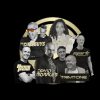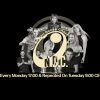-
 play_arrow
play_arrow
Clubalicious Clubalicious Radio
-
 play_arrow
play_arrow
London Calling Podcast Yana Bolder

For the Wicked dance sequences with added laughter and reactions, like Fiyero’s song “Dancing Through Life” in the library, they cast actual dancers for the loop group. Nugent Title worked with Wicked choreographer Christopher Scott, who brought ten of the best dancers in Los Angeles to a session with ADR mixer Doc Kane at Walt Disney Studios in Burbank, Calif. The dancers watched the sequence a couple of times to get the rhythms and movements, and then were recorded as a group.
“We did a lot of recordings like that,” says Nugent Title. “For instance, when Elphaba enters the Ozdust Ballroom, there’s a dance circle happening off-screen. Everybody’s watching one person in the middle, and then the music stops, and they all shift their focus. Jon wanted to hear that in the group. So for the session, we actually had all these dancers standing around one dancer who was breakdancing in the middle They were listening to the music from the film, so it was all in time with the scene.”
BLENDING GROUP AND VOCALS
At times, the loop group recordings shift into the ensemble vocals during the songs, as Marquis explains: “Robin [Baynton], Jack [Dolman], Jon and Myron would talk about the camera moving through the crowd in Emerald City, and so they wanted to hear this one person come by singing the chorus. They talked about the immersive nature of these individual voices and made little choices to feature this particular voice or that voice as we go by. This gives the audience a sense of the magnitude of the crowds.”
To then balance that bigness at the mix, Nelson says, the vocal ensemble was presented as a 5.0 or a 7.0 track that would accompany the main singers and the orchestra. Within those stems, there was the ability to push any particular singer a bit forward or back in the mix, depending on where the camera was. With the loop group, everything was completely separate all the time. “Nancy and I agreed early on that the loop group would come to me as a virtual mix that Nancy would handle,” Nelson notes. “We didn’t want to tie too many things together. A conventional pre-dub would have been hard to unpick.”
Because Nugent Title had all the loop group tracks in a separate Pro Tools session, she could premix specific tracks to match what was happening on screen, like featuring specific voices on camera pans and adding reverb, before sending the tracks to Nelson on the DFC.
Nelson then mixed the dialog and vocals together, treating the vocals like dialog instead of music. “I think of the vocals as part of the spoken word because they’re telling a story,” he says. “You don’t want to suddenly go into a song and feel like you’re in a different place. I marry the vocals and the dialog very tightly together so that it’s a seamless transition when we go in and out of spoken word.”
What ultimately sets Wicked the movie apart from the stage production is the film’s ability to immerse the audience in the magical world of Oz. Marquis says, in summary: “The world is completely built out with incredible detail, down to all the elements in the production design. The sets relied heavily on practical elements—like the big Wizard of Oz head that was controlled by puppeteers—so the actors got to interact with a real environment. The visuals are dense, and the soundtrack is dense, but it’s also very soft and round, warm and inviting. Sonically, there was plenty of space for all the music and all the on-screen sound design and effects. There was not one aspect, from production to post, that did not feel intertwined and fully supported by the other crafts.”
Written by: Admin
Similar posts
Recent Comments
No comments to show.Featured post

Latest posts
Current show

Femme House
Lp giobbi
FEMME HOUSE RADIO showcases a diverse array of creators, executives, and allies, with a focus on female, gender expansive, BIPOC, and LGBTQIA+ voices. Since launching in February2021, the show has broadcast nearly 150 hours of music by non-male DJs. Hosted by FEMME HOUSE co-founder and Artist-in-Chief LP Giobbi, each episode features an hourlong mix from the featured guest, with a long form interview rebroadcast on FEMME HOUSE’s Twitch and YouTube channels.
closeUpcoming shows

Stereo Productions
Chus Ceballos
20:00 - 21:00
Fresh Is Fresh
This Weeks Hottest Releases
21:00 - 00:00
Love To Be
The Global Connection
00:00 - 02:00
Fresh Is Fresh
This Weeks Hottest Releases
02:00 - 09:00
Norwegian Dance Chart
Top 40 Hottest Tracks in Norway
09:00 - 11:00Chart
Powered by Dee jay promotions visit us












 Invalid license, for more info click here
Invalid license, for more info click here